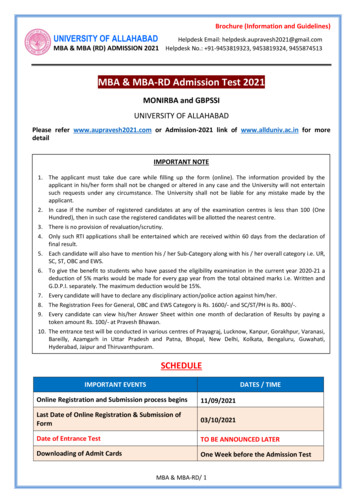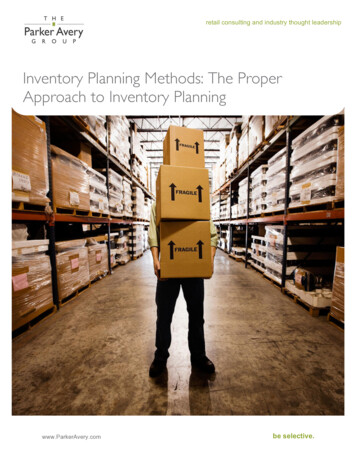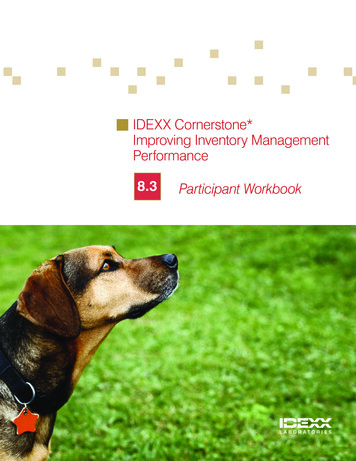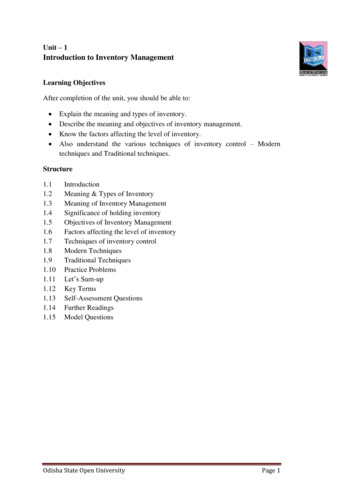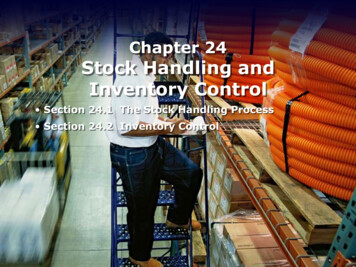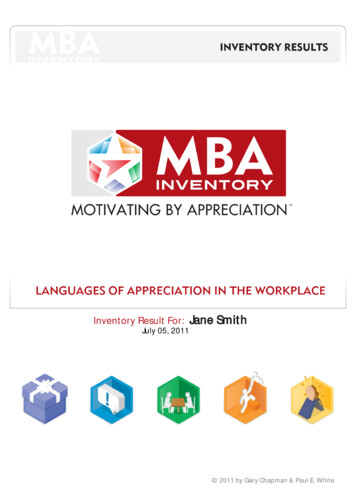
Transcription
Inventory Result For:July 05, 2011Jane Smith 2011 by Gary Chapman & Paul E. White
CONCEPTUAL FOUNDATIONResearch has demonstrated that individuals are motivated and encouraged in a variety of ways. Inpersonal relationships, individuals both give and receive appreciation with one another in five basicbehavior patterns -- through words of affirmation, acts of service, giving gifts, spending quality time,and physical touch. (Please see the book, The Five Love Languages by Gary Chapman or go towww.fivelovelanguages.com for more information.) It is important to note, however, that anindividual’s preferred way of receiving appreciation in a personal relationship (that is, family orfriends) often differs from how they feel encouraged in a work-related setting. And one language(physical touch) which is an important language in personal relationships has been found not to be assignificant in work-related relationships.The Motivating By Appreciation inventory is designed to gain a clearer picture of an individual’sprimary language of appreciation and motivation as experienced in a work-related setting. Individualsdiffer in how they experience feeling appreciated at work. Some people prefer to be told that theyare doing a good job; others feel valued when their supervisor spends individual time with them.Some team members are encouraged if their colleagues work with them to complete difficult tasks,while others are motivated by tangible rewards received for a job well done. (These issues areaddressed in The 5 Languages of Appreciation in the Workplace: Empowering Organizations byEncouraging People (to be released in July 2011).Generally, most individuals attempt to communicate appreciation and encouragement to others byutilizing their preferred “language” of appreciation. This works well when the individual on thereceiving end of communication has the same language of appreciation or encouragement. But whenindividuals have differing motivational languages, the message sent (with good intention) tends to nothave the desired positive impact on the individual who has a different motivational language. Thismiscommunication, due to differing values of what is encouraging or motivating, can create hardfeelings by both the sending party and the receiving party.Therefore, understanding an individual’s primary languages of appreciation, motivation andencouragement can assist managers and supervisors in communicating effectively to their teammembers. This can lead to effectively communicating appreciation for work well done, and fordeveloping a plan for rewarding team members in ways which they will value.The M.B.A. (Motivating by Appreciation) Inventory is designed to gain a clearer picture of anindividual’s primary language(s) of appreciation and motivation. Secondarily, it also helps inidentifying those ways in which an individual is not motivated or encouraged. 2011 by Gary Chapman & Paul E. White
The questions in the inventory (30 pairs of questions) have the respondent choose between variousways they prefer receiving appreciation or encouragement in a work-related relationship. Theresponses are then tabulated and the respondent’s two primary languages of encouragement areidentified, along with the language which is the least important to that individual.)RESULTS FOR JANE SMITHJane Smith's Primary languageJane Smith’s primary language for feeling appreciated in the work setting is by spendingquality time with those she values. If Jane Smith’s supervisors, colleagues or team memberswant to encourage or help her feel valued, they can: Invite her to do something with them. Stop by and see “how she is doing” Spend time individually with Jane Smith. Give her their full and undivided attention. Take time to listen to her concerns.There are different types of quality time in the workplace, and individuals differ significantlyin which is most meaningful to them. Some people highly value “focused attention” (havingyour undivided attention while being with you). Others just enjoy companionship (“beingthere” with them), while to some experiencing a personal connection through listening andsharing is important. Finally, a number of individuals really appreciate shared experienceswith their colleagues (going to sporting events or other activities together).It is just as important to spend the right type of time to effectively encourage yourcolleagues, as it is to use the correct language. So take note of the actions items that JaneSmith endorsed. These will help you “hit the mark” more accurately.Quality time with people who are important to her helps make Jane Smith feel like she is asignificant part of the team. She likes to feel included by others. A critical aspect of “qualitytime” for Jane Smith is that a part of the time should be focused on listening to what isimportant to her. 2011 by Gary Chapman & Paul E. White
Jane Smith's Secondary languageAn additional way that Jane Smith receives encouragement and is motivated is by words ofaffirmation. Jane Smith highly values being told that she has done a good job.Additional ways to make Jane Smith feel valued and appreciated is to: Communicate specific character qualities you observe and value in Jane Smith. Praise Jane Smith for work well done, both privately and in front of others. Compliment Jane Smith for successes accomplished, both personally and done by herteam. Simply tell Jane Smith she did a good job on specific projects and tasks.Jane Smith’s secondary language of appreciation is important in two regards. First, itprovides an alternative way to express appreciation and encouragement to her that shevalues. Secondly, combining a person’s primary and secondary languages of appreciationcan communicate more powerfully than either language used by itself.Jane Smith's least valued language of appreciationJane Smith’s lowest language of appreciation in the work setting is receiving gifts. Therefore,attempts to motivate or encourage her by giving her things will generally not be thateffective.Although these actions may be appreciated by others, gifts (such as birthday cards, gifts,tickets to sporting events, or other small tokens) are not that important to Jane Smith.(NOTE: this does not include bonuses or pay increases!).Additionally, it is important to note that Jane Smith may actually enjoy receiving gifts thatare meaningful to her, but generally in work-based relationships they are not as valued byher as Quality Time or Verbal Praise.Action CheckList (Time) 2011 by Gary Chapman & Paul E. White
Although it is helpful to know an individual's primary and secondary languages of appreciation, thereare still many variations of expression within each language. Therefore, we have found that it ishelpful to know which specific actions are valued most by each individual. This eliminates the needfor guessing by one's supervisor, manager or colleagues -- they can know exactly what will beencouraging to Jane.Here are the items Jane endorsed as those actions which will most clearly communicate a sense ofappreciation to her.Go to lunch together to talk about business issues. (Supervisors and Colleagues)Go to lunch together and not talk about business issues. (Colleagues)Invite me to go to lunch with a group of colleagues. (Colleagues)Stop by, sit down in my office and check in with me regarding how things are going. (Supervisors)Go to dinner together with our spouses / significant other. (Colleagues)Have an away from the office retreat for our team. (Supervisors and Colleagues)Go see a movie together. (Colleagues)Have a weekly “check in” meeting to see how things are going. (Supervisors and Colleagues)SummaryFocusing on communicating appreciation to Jane Smith through the languages of appreciation thatare most meaningful to her (Quality Time and Verbal Praise) will be more likely to produce the desiredeffect of Jane Smith feeling appreciated and valued by her supervisors and co-workers, and willultimately make her daily work experience more positive for her.REMINDER: The MBA Inventory is not a psychological test, and the results should not be construed tobe such. Rather, the MBA Inventory is a self-report instrument which gathers, processes, andsummarizes the information you provide.For additional information and resources for applying the MBA Inventory results in your work setting,please go to www.drpaulwhite.com. This includes free resources to use with your group (e.g. groupprofiles), purchasing additional MBA inventories for your team members, having training done withyour organization, or having someone speak to your business or association. 2011 by Gary Chapman & Paul E. White
and physical touch. (Please see the book, The Five Love Languages by Gary Chapman or go to www.fivelovelanguages.com for more information.) It is important to note, however, that an individual’s preferred way of receiving ap



